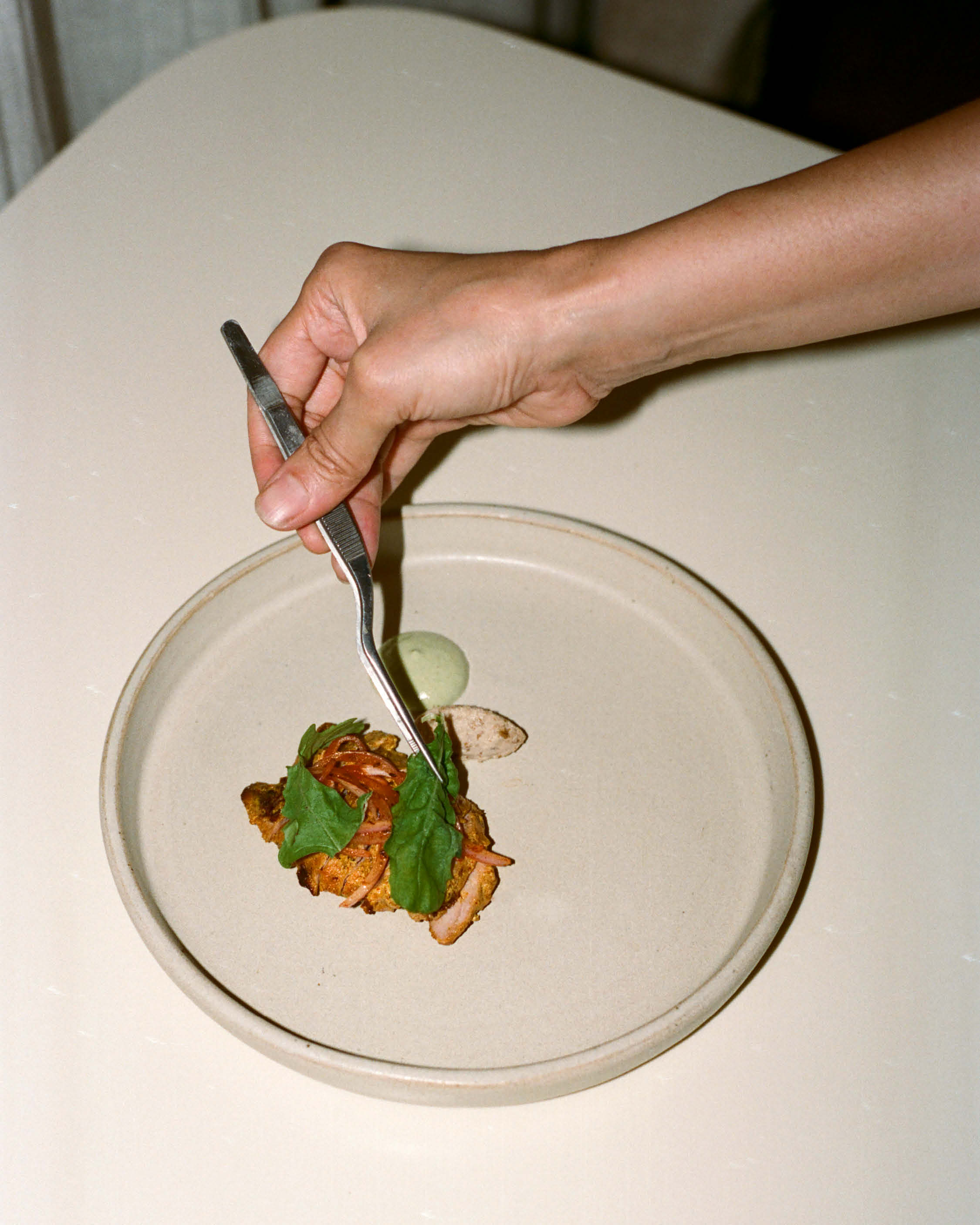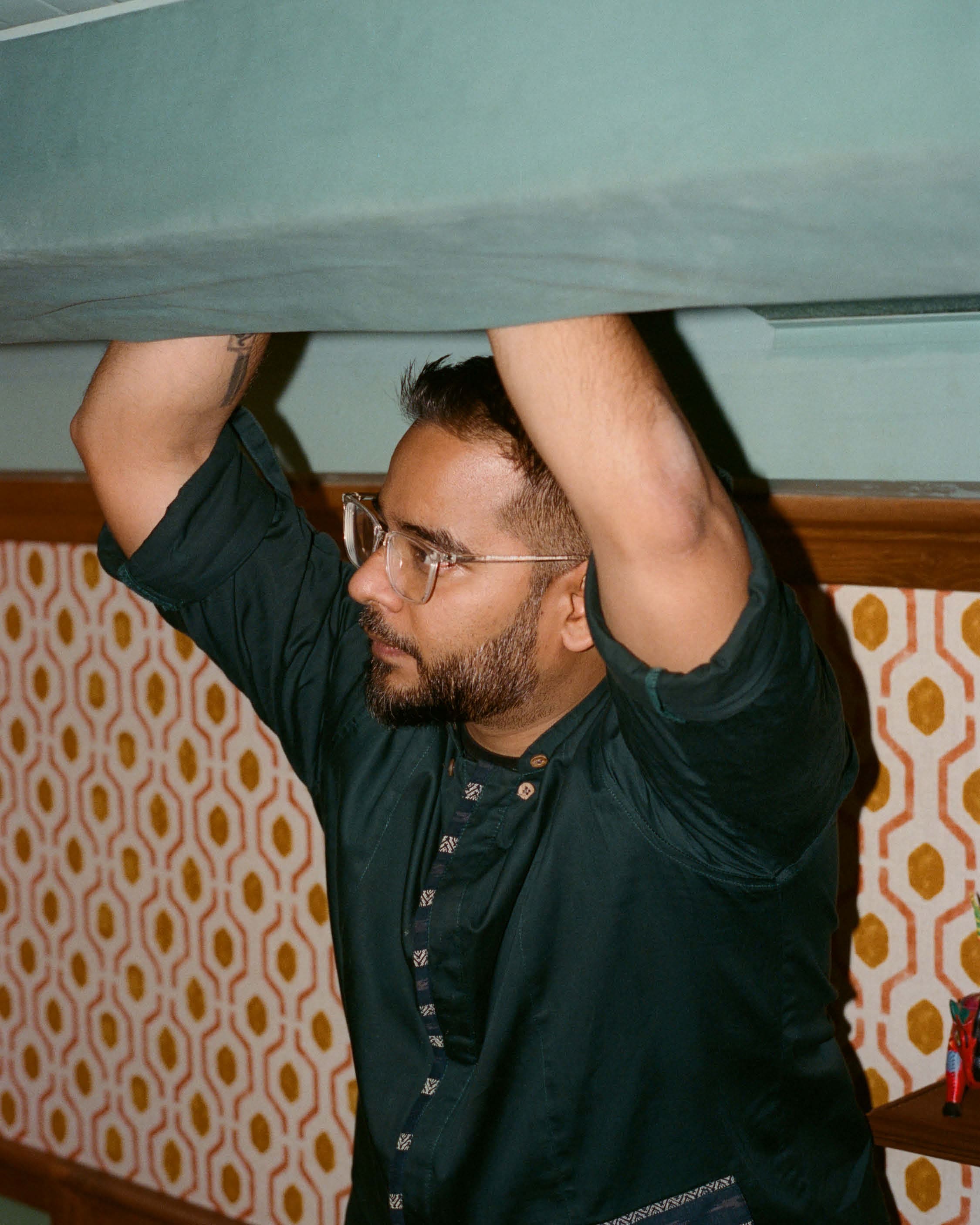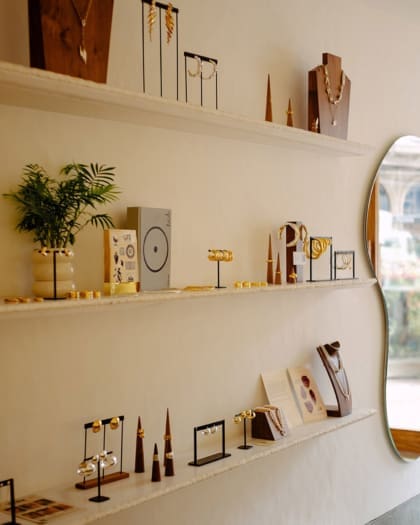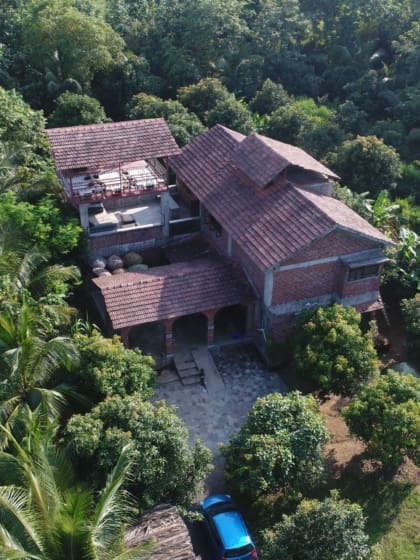
Meet the Mumbai chefs redefining Indian cuisine
Four leading Mumbai-based chefs discuss paving the way for modern Indian cuisine in the city’s food scene
Mumbai’s constantly evolving culinary landscape offers up some of the most forward-thinking dining experiences in India. A new generation of chefs and tastemakers are pushing the boundaries of Indian food, combining experimental formats with heritage ingredients and time-tested cooking traditions. Armed with international training, they are building a strong case for an ancient cuisine mired in stereotypes, making it fun and relevant for the global palate. Travel is a key source of inspiration, allowing them to play with diverse regional flavours beyond the usual butter chicken and biryani. Their mindful approach also takes them outside the kitchen, engaging with food growers and indigenous communities to address sustainable food systems.

Vanika Choudhary, chef and founder at Noon
Vanika Choudhary’s earliest memories of food are of her grandma’s pickles. Born in Kashmir and based in Mumbai for more than two decades, she is the chef and founder of Noon, a high-end restaurant situated in the business district of Bandra-Kurla Complex. The name means ‘salt’ in Kashmiri, nodding to the restaurant’s focus on India’s ancient practice of food preservation through pickling.
Choudhary quit her advertising career a decade ago to dive into fermentation, a custom she says is integral to her cultural identity. Her nuanced understanding of flavours and techniques comes from her travels across India, primarily in the Himalayas, where she continues to work with ethnic communities to preserve, document and spotlight the provenance of regional ingredients, such as woolly catmint from Ladakh, heirloom rice from Kashmir, seaweed from the western coast and edible flowers and hyperlocal greens from the Western Ghats. Her tasting menus change every season and promise an immersive journey into her fermentation expertise, with more than 140 misos, kojis and garums.
Choudhary is self-trained and has collaborated with Michelin-starred chef Ken Sakamoto of Cenci in Kyoto, the zero-waste chef Douglas McMaster of Silo in London and Buddhist nun Jeong Kwan – the Korea-based authority on fermentation and temple cooking. She also picked up the La Liste New Talents of the Year award in 2023.


How did your early years in Kashmir shape you as a chef?
My love of food grew from packing picnic baskets with my nani. We always ate Kashmiri staples like mutsch (spicy meatballs), yakhni (yoghurt-based lamb curry), meat with sun-dried apricots or quince, lots of salty noon chai and breads that we’d pick up from the nanwai (local bakery). I also remember picking nadru (lotus stem) from Dal Lake – an act of foraging that I value now. Watching my father’s wild enthusiasm for growing everything from alpine strawberries to morels and my mother’s annual ritual of sun-drying vegetables for winter struck a chord only when I left home.
These experiences made me realise that although our food was different from the rest of the country, mostly due to the climate, we were united by our preservation techniques – for instance, pickles are a common affair across Indian homes. My nani prepared 40 to 60 varieties of pickles depending on the season. I want to familiarise my diners with this aspect of our tradition.

Is there a story behind Noon’s striking tableware?
The idea was to bring the hills home – the hills being where I was born and home being Bombay. It is important to me that the produce is in sync with the vessels the food is served in. Since Ladakhi cuisine takes centre stage at Noon, we use bowls made of poplar wood, which is abundant in the mountains, and bread baskets handwoven by farmers there. Our brass cutlery has intricate carvings that are inspired by the typical designs on a thap, a traditional clay stove central to a Ladakhi kitchen that dates to the 17th century.
During a residency in Bhutan, I found similar carvings in a farmhouse, which got me thinking about how the influence is common across the Himalayan belt.

What are some of your favourite ferments you’ve enjoyed developing?
I have a special memory of eating rajma-chawal, a red kidney bean gravy served with rice and typically eaten on Sundays. The longing for home prompted me to interpret a rajma-chawal miso as an ode to those times. There’s pumpkin kasundi, which is my take on the quintessential Bengali condiment, but elevated with leftover pumpkin peels, foraged herbs and mustard from Ladakh. And of course, Bombay duck and roselle garum, inspired by Mumbai’s vibrant Koli community.
What excites you about living and working in Mumbai?
Bombay is a truly eclectic melting pot of cultures, which is very inspiring. How many cities allow you to eat a Koli seafood thali, grab chaat by the streetside or experience a Bohri meal? The progressive culture is a bonus. I can serve fermented fish, which is often ridiculed for its overpowering aroma, and yet is so integral to the city’s coastal community. The geography matters as much as the history, and the city is open to that kind of storytelling.
Where to eat in Mumbai: Shree Thaker Bhojanalay for Gujarati thali, Jai Hind for coastal food, The Table in Colaba and Bandra Born.

Varun Totlani, head chef at Masque
There was a time between projects when Varun Totlani considered starting a cloud kitchen serving sausages. Yet the 31-year-old chef now helms the kitchen at Masque, an upscale, ingredient-first restaurant housed in a bygone former textile mill in Mahalaxmi, South Mumbai. Born and partly raised in Mumbai, he is best known for an experimental approach to traditional Indian food and his use of rare, seasonal produce from across the country.
When Masque, part of the Relais and Chateaux group, opened in 2016, it was the first of its kind in the city to offer a ten-course tasting menu. Totlani joined the team as a commis chef in the same year after graduating from the Culinary Institute of America in New York. Since then, he has honed his craft through extensive research trips and brings a contemporary flair to ordinary ingredients. Signatures from his menus include the popular Indian street-side snack bhel, here tossed with seaweed harvested from the Goan coast, a thali featuring regional classics and a fun twist on pani puri with a juicy filling of sea buckthorn sourced from Ladakh. With Masque appearing on Asia’s 50 Best Restaurants List 202 three years in a row, Totlani has also collaborated with world class chefs such as Daniel Humm of Eleven Madison Park and Jordy Navarra of another Asia’s 50 Best award winner, Toyo Eatery in Manila.


Which dishes have you particularly loved developing for Masque?
I absolutely loved working on the thali. It is a celebration of abundance and of how we eat in our homes. Our idea was to go beyond the usuals as every region and family has their own take on it. The centrepiece is a tandoori soft-shell crab inspired by Mumbai’s classic seafood joint Trishna. There is saag (seasonal greens) that we serve with indigenous ladyfish employing the Japanese grilling technique of matsukasa yaki. Another favourite is the cacao dessert, which is our way of spotlighting Indian cacao and India’s bean-to-bar revolution. It is multi-layered and multi-textural, and uses the entire fruit in some form, including the shells, which would otherwise be dumped or used as biofuel.
How has travel informed your research?
In Goa, I learned that there are around 800 species of seaweed in India, which is an unimaginable number. In Rajasthan, I learned about khad, an ancient pit-cooking practice popularised by the royals, who’d go hunting for game and cook it underground, wrapped in layers of jute and spare cloth or leaves for several hours.

What are some of your biggest learnings from international collaborations?
It’s a great exchange programme, almost like a crash course where we learn from each other. But there are challenges. For instance, collaborating with Eleven Madison Park in New York was a whirlwind of emotions. The menu had to be plant-based, so everything from our signature ladi pav (Indian-style dinner rolls) to kulfi (traditional ice-cream) had to be dairy-free. But I have to admit it is one of the highlights of my professional career.
My favourite collaboration was with chef Jordy Navarra of Toyo Eatery in Manila. Given both Mumbai and Manila have a vibrant street-food culture, we did live stations showcasing the varied experiences. The Kamayan meal, which is a Filipino communal feast eaten with hands, was also something that I found similar to our Bohri thaal, where we typically share a big platter together.
Where to eat in Mumbai: Swati snacks, Trishna for seafood, Ayub’s at Fort for mutton seekh, Mohammad Ali Road during Ramzan, pav bhaji at Sukh Sagar, dosas at Muthuswamy and Madras Cafe.

Hussain Shahzad, executive chef, Hunger Inc
Indian cuisine did not initially excite 36-year-old Hussain Shahzad, who grew up in a Bohri Muslim family in the southern city of Chennai. After graduating from culinary school, he worked at the Oberoi Group cooking European food before landing at Eleven Madison Park in New York, where cooking under a chef of Daniel Humm’s calibre left a lasting impression on his culinary sensibilities.
Shahzad returned to India two years later and joined The Bombay Canteen in the industrial district of Lower Parel, working under the mentorship of the celebrated Indian-American chef Floyd Cardoz (one of the founding partners at Hunger Inc, the Indian hospitality group that owns O Pedro, Bombay Sweet Shop, Veronica’s and Papa’s). It was a role that proved to be a game-changer and in 2017, he simultaneously took over the kitchen at O Pedro, a Goan-Portuguese restaurant inspired by Cardoz’s Goan roots.
Today, The Bombay Canteen is a crowd favourite whose fun and casual take on regional food manages to break the stereotypes around a centuries-old cuisine that’s continuously debating its own authenticity. The menu features dishes steeped in nostalgia and tradition, but reimagined with modern techniques. Classics include thepla tacos, a take on the cult Gujarati flatbread, a barley salad that imitates a Mumbai chaat, gulab nut – a doughnut-shaped gulab jamun soaked in rum – and podi beef tartare inspired by Shahzad’s memories of eating leftover meat curry for breakfast. The Bombay Canteen made it onto Asia’s 50 Best Restaurants list for 2024 and in February, he introduced Mumbai to Papa’s, an intimate 12-seater chef’s counter restaurant that focuses on playful Indian flavours.


You weren’t initially interested in cooking Indian food. What changed for you?
I think chef Cardoz’s approach of starting from a point of zero ignorance touched me. He made me ask questions, which allowed me to find my own voice. Back then, everyone was trying to make the best version of butter chicken, but we didn’t want to make it. Our cuisine is so steeped in tradition and battles over authenticity that we forget that even a biryani was originally someone’s innovation. The Bombay Canteen was an exercise in flavour profiling, where we celebrated the ethos of the cuisine rather than following any specific recipe.
Have any travel experiences influenced you as a chef?
My trip to Portugal as part of the menu research for O Pedro made me understand how colonisation impacted the food culture in Goa. I ate my way through Lisbon, connected with chefs and worked at tabernas to gain a strong perspective on the cuisine. For instance, the classic Goan vindaloo is influenced by vinha d’alhos, which is believed to have travelled with the Portuguese to Goa in the early 16th century.

What’s special about Mumbai?
It’s the sense of community that makes Bombay beautiful. It is the only city where I can casually tell the guest eating at the next table “Hey, try this, it’s delicious,” and they are not going to mind.
How should a first-timer to approach the city’s food spots?
I’d want them to eat the traditional take first, and then try the modern variation. You gain a fuller understanding of the context of a vada pav if you eat at institutions like Ashok Vada Pav, rather than going straight for a deconstructed version. An Indian-Chinese meal is also a must.
Where to eat in Mumbai: Canara for seafood, Mizu for Japanese food, and Americano at Kala Ghoda.

Niyati Rao, chef and co-owner, Ekaa
Mumbai chef Niyati Rao wanted to work with food from an early age. As a dyslexic child, her interest in creative arts, and eventually food, grew during her travels along with her parents. Today, she is the brain behind Ekaa, a cuisine-agnostic restaurant inspired by her trips across India, housed in a restored colonial building in the heritage precinct of Fort.
After culinary school and a stint working at the iconic Taj Mahal Palace, Rao was drawn to the research and development aspect of her training. In 2019, an internship at Noma in Copenhagen allowed her to discover the potential of her own cuisine. She returned home the following year, driven by an urge to showcase the diversity of Indian ingredients, especially those that rarely make it to the mainstream dining scene. Trout roe from Kashmir, sea urchin from the southern coast, mountain pepper from Nagaland and red weaver ants from Chhattisgarh in central India are a few that excite her. Landing a spot in the past two years on Asia’s 50 Best Restaurants list, Ekaa means ‘unique or matchless’ in Sanskrit – a concept that Rao wants to champion through modern interpretations of traditional flavours.


How would you describe your experience working at Noma?
Noma was pathbreaking in every sense. There was one period where I’d prepare 80 fruit beetles everyday. The meticulous attitude is infectious and I knew it required immense conviction and courage. The way they made optimum use of humble ingredients is magical. I thank Noma for teaching me to treat every ingredient with equal respect.
What led you to open Ekaa?
It was family night at Noma, where the chefs came together to cook for each other. I had made a sweet and sour tamarind chutney, which got the R&D chef Mette Søberg to come to me asking for the recipe. When I told her there were about 11 ingredients, she was stunned. I realised it was a condiment, yet was more complex than what many people understand to be the sum of Indian food – the world knows us for curry and sometimes not much else. This got me thinking about how spectacular Indian cuisine is, and we are sitting on a goldmine given our diverse geographical landscape. I opened Ekaa to celebrate India through its food, people and memories.

Is there a specific region that excites you the most?
It has to be Nagaland in northeast India. I have been hooked on the food for several years thanks to a friend who introduced me to the incredible produce there, like fermented bamboo shoots, ghost peppers and axone (fermented soybean). I was so intrigued by the offbeat flavours that I decided to travel across Nagaland last year to develop a tasting menu at Ekaa. Naga food is often dismissed for its funky flavours but it is packed with umami. Imagine: there are about 17 tribes and each of them has their own style of cooking. They are the masters of smoking and fermentation and sadly not many people know about it. And this is just one state out of 28 in the country.
How does Mumbai influence your thought process?
It inspired me to design a majority vegetarian menu. We are situated in South Bombay, where most people do not eat meat. My half-Gujarati lineage also partly inspired the decision. If I am an ingredient-driven chef, I cannot be biased. Although I am a hardcore non-vegetarian, a vegetable is no less important than meat.
Where to eat in Mumbai: Ling’s Pavilion for Chinese food, Sernyaa for Tibetan food, Sandeep Gomantak for Malvani cuisine, Ram Ashraya for south Indian food, Shree Dutt for Maharashtrian snacks and Britannia & Co for Iranian food.







